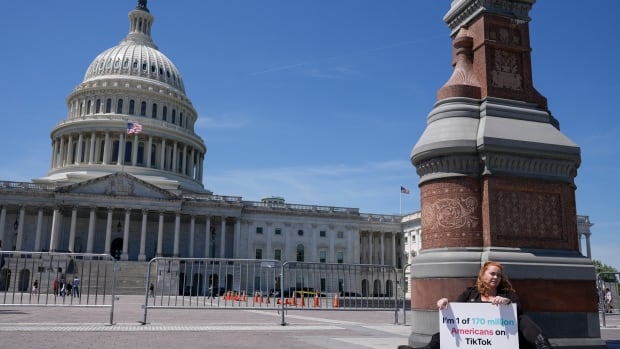After Iowa, New Hampshire, and South Carolina, a major swing state has finally voted in a 2024 U.S. presidential primary, offering some electoral tea leaves to read.
The main takeaway from Tuesday’s Michigan primary: Two vulnerable candidates are barrelling toward the nomination of their respective parties.
Joe Biden and Donald Trump each cruised to victory in Tuesday’s vote. But the results also revealed blinking warning lights up ahead.
Here are the takeaways. With one positive, and one negative, for each of the likely presidential nominees.
A Gaza warning for Biden
There has been evidence for months that the war in Gaza has angered many Democrats and risks costing Biden some of the votes helped him win in 2020.
Tuesday night was the first major electoral test of that, in the swing state with the highest population of Arab Americans.
A large number of Michiganders turned out to protest Biden’s support for Israel. Approximately 13 per cent of Democratic voters lodged a protest vote, with more than 100,000 declaring themselves uncommitted.
This followed a campaign by progressives and Democrats like congresswoman Rashida Tlaib, who said their goal was to send Biden a warning.
“This is the way we can use our democracy to say, ‘Listen. Listen to Michigan. Listen to the families that have been directly impacted,'” said Tlaib, who is of Palestinian origin and has relatives there.
On Tuesday night, organizers of the protest immediately declared victory.
It was the largest-ever number of such uncommitted voters in a Michigan primary, with the exception of an unusual intra-party dispute in 2008 where several candidates, including Barack Obama, didn’t appear on the primary ballot.
It was also the largest percentage to ever vote uncommitted in Michigan, surpassing the 10.7 per cent who did so when Obama was up for re-election in 2012.
Those numbers will cause some hand-wringing in the White House, given how a protest vote in November could easily swing the election in closely-fought states.
Michigan is a prime example of a state where almost every vote counts.
In 2016, Trump won Michigan by just 0.3 percentage points (fewer than 11,000 votes), and Biden won it in 2020 by 2.8 percentage points (about 154,000 votes).
But don’t declare these numbers as calamitous for Biden just yet.
There’s no telling how many of the protest voters will actually oppose him in November. Or whether they will be numerous enough to change the election result.
Just look at what happened in 2012. After being rebuked by so many uncommitted voters in the primary, Obama went on to win the state of Michigan in the general election by almost 10 percentage points and he was easily re-elected.
Some Michigan Democratic primary voters plan to protest U.S. President Joe Biden’s handling of the war in Gaza by choosing ‘uncommitted’ on their ballots. As a key swing state with a large Arab population, they hope a strong showing will cause the administration to take a different approach.
Good news for Biden
There were bright silver linings on the evening for Biden. He appears to have squashed, easily, long shot primary challenges against him.
Biden appeared poised to get more than 80 per cent of the Democratic vote. His most significant challenger, congressman Dean Phillips, registered a paltry couple of percentage points.
But that’s not all.
Biden overperformed in polls – again. There hasn’t been much polling of Democratic primary races, but he appeared to finish 10 percentage points higher than in his surveys in the state.
It’s becoming a pattern. Biden outperformed a similar survey in South Carolina by a whopping 30 percentage points, winning 94 per cent of that state’s primary.
More than that, Democrats have done well in recent elections, including a byelection this month in New York City where they won the seat of disgraced lawmaker George Santos seat by 13 points.
All of which might give Democrats some hope that they, and Biden, are in better shape this year than the polls suggest. Because the polls lately suggest they are losing to Trump.
U.S. President Joe Biden says he’s been advised a ceasefire between Israel and Hamas could be reached by Monday, March 4, but warned that it is ‘close … but not done yet.’
Trump’s primary fight: It’s over
Trump is not officially the presumptive nominee for the Republicans. Not yet. That title officially gets conferred after a candidate locks up a majority of convention delegates, which in his case is expected to happen within the next three weeks.
Make no mistake: It’s happening.
After easily defeating Nikki Haley in her home state of South Carolina last weekend, Trump has won a sixth state or territorial primary. In Michigan, Trump trounced his former cabinet member by about 68 per cent to 26 per cent, with a fraction of the votes still being counted.
Another encouraging sign for Trump was the far higher Republican than Democratic turnout. It’s hard to make an apples-to-apples comparison, as the races are different, one involving a sitting president and the other a former one making a comeback.
But in this first contest of 2024 where Biden and Trump appeared on ballots on the same night, about one-quarter more Republicans showed up than Democrats.
A Democratic lawmaker from Michigan said she expects a close election fight to last through November.
“This is going to be a tough election year,” Debbie Dingell told CNN. “It’s going to be a purple state until election day,” meaning a competitive state.
Trump repeatedly under-performing polls
Trump is steamrollering his primary opposition. He barely even mentions Haley anymore, and casts himself as already preparing for the general election.
He did briefly allude to Tuesday’s primary results, calling his victory even more dominant than he had anticipated.
“The numbers are far greater than we even anticipated,” Trump said.
But something unusual is happening with those numbers. Unlike Biden, he is significantly under-performing his polls.
It’s a confounding pattern from the first few primaries. The former president is racking up win after win. But he’s not getting the margins he’s seeing in surveys.
There are different theories about why that’s happening. Is this a temporary phenomenon where pollsters are struggling to measure the number of Democrats voting in Republican primaries? Or is it a real problem for Trump?
In Iowa, his actual victory margin was four and five points smaller than in the polling numbers on two well-known websites that aggregate surveys.
In New Hampshire, it was seven and eight points lower than on those two polling sites. In South Carolina, it was three and eight points lower than his polls.
In Michigan, his share of the electorate fell shy of his score in recent polls by about 10 points.
It’s notable because so much has been made of the so-called shy Trump voter, who won’t talk to a pollster but will turn out to vote. He famously outperformed surveys in 2016 and 2020.
His opponents will hope that the shy Trump voter is a thing of the past. And that they — not Trump — will have a surprisingly strong showing this November.









